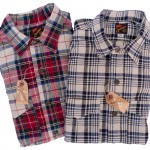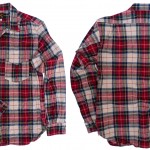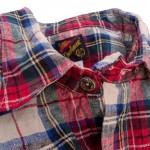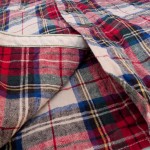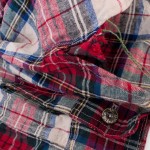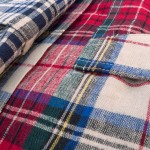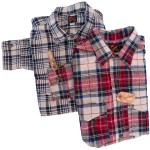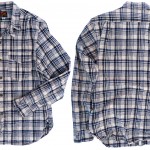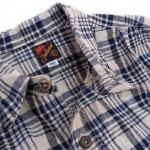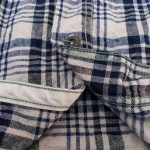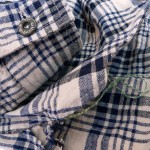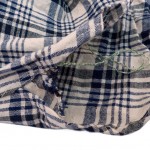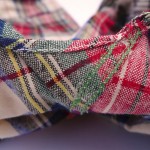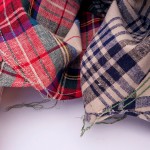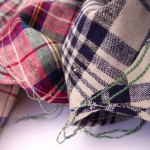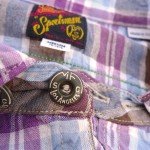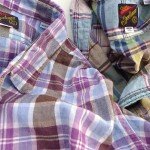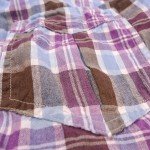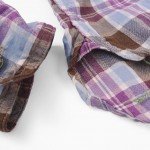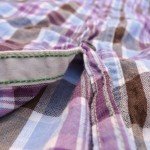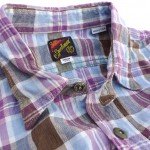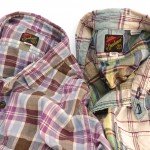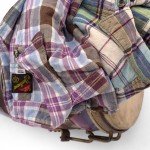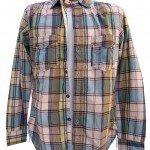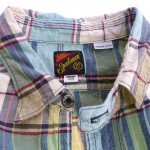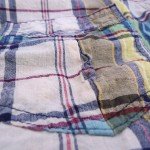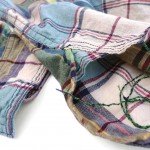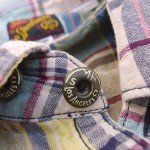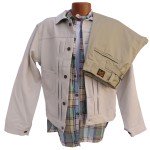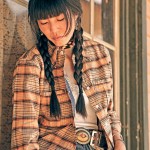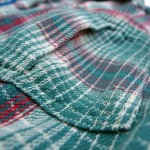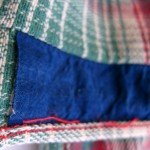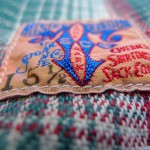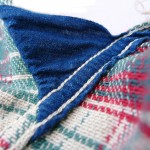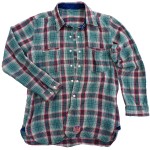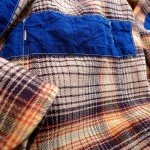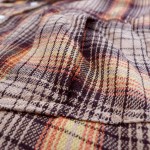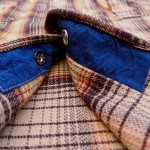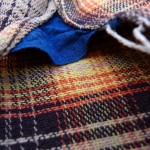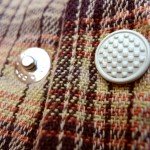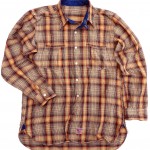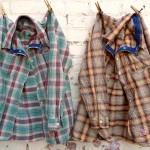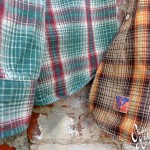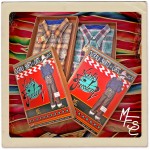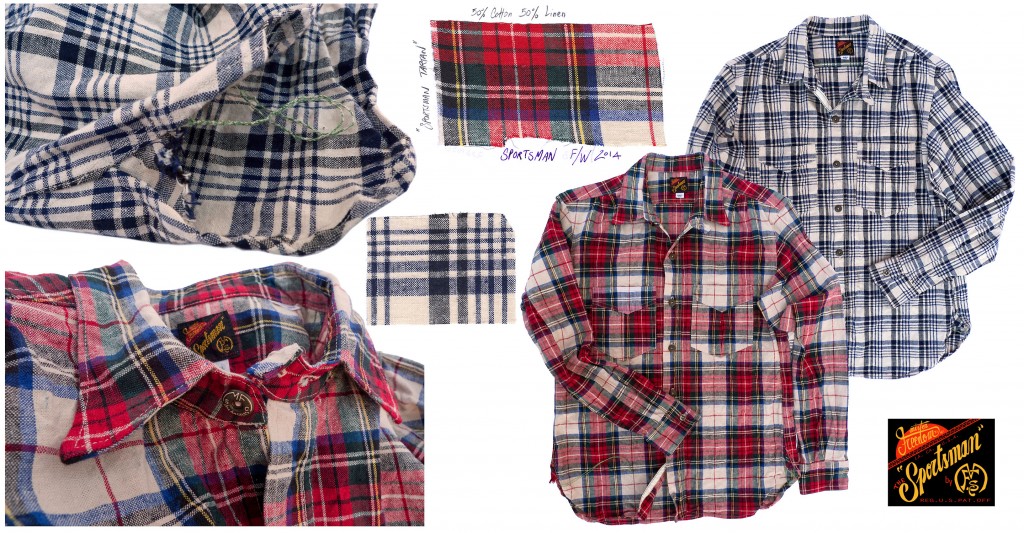
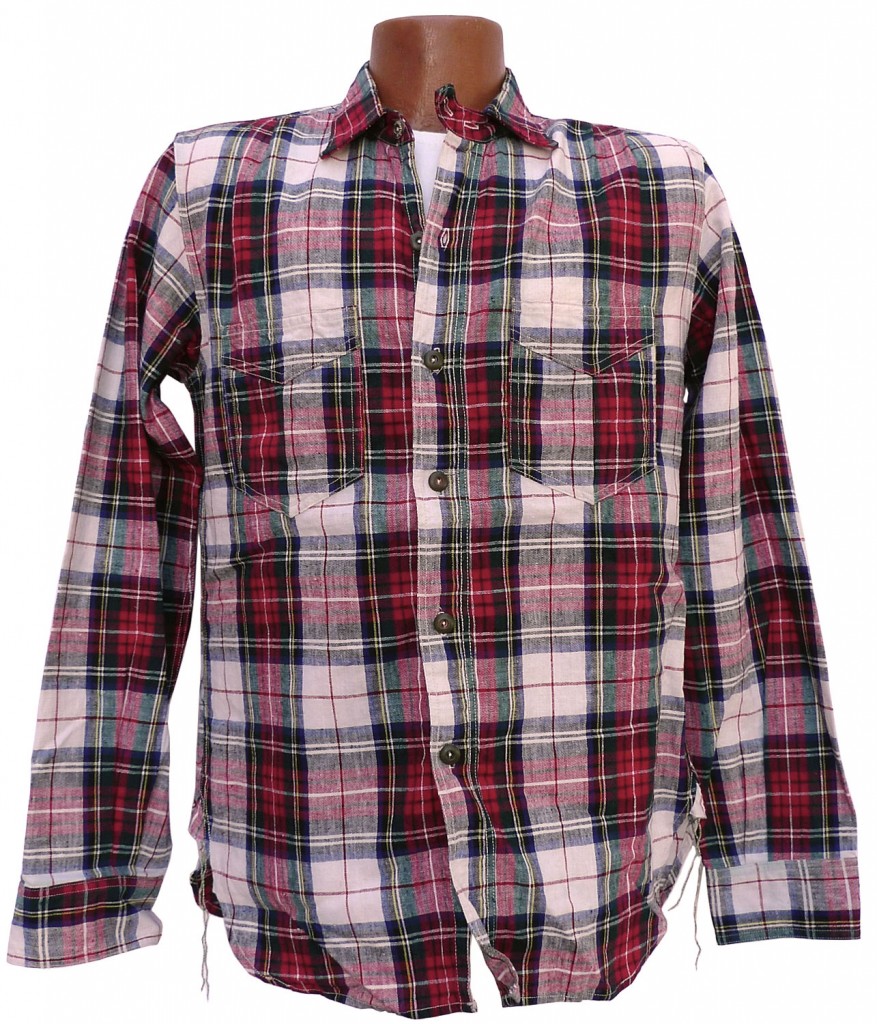
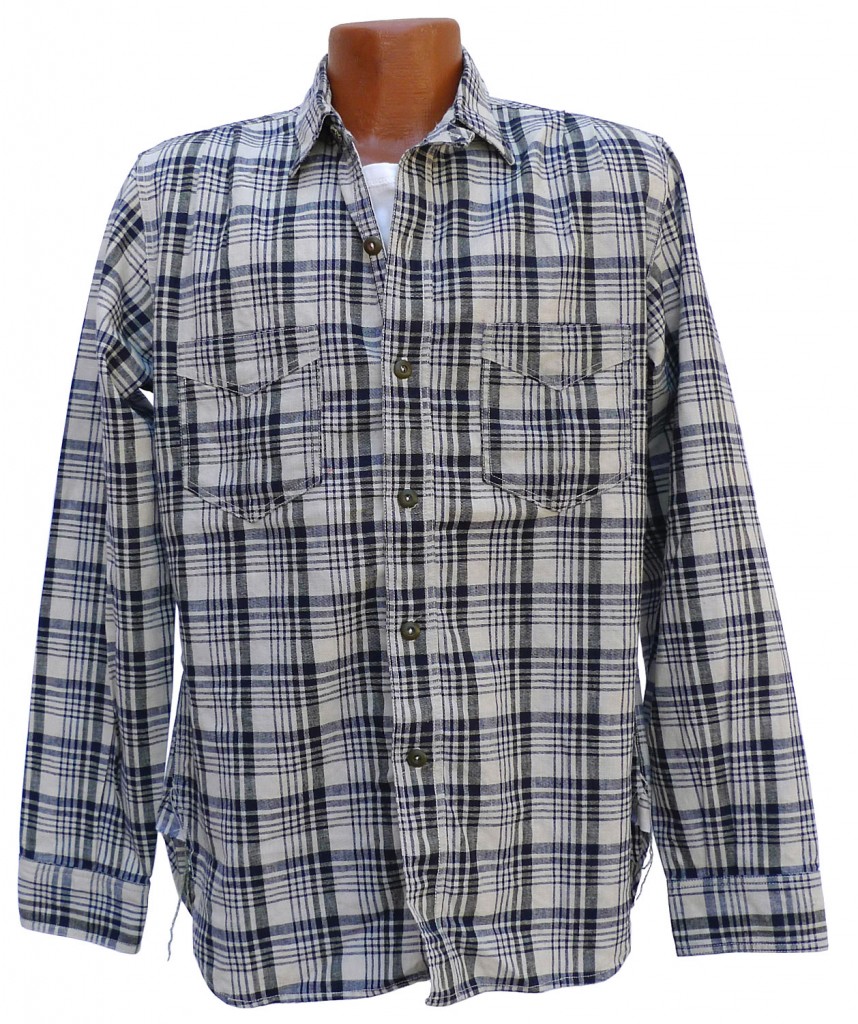
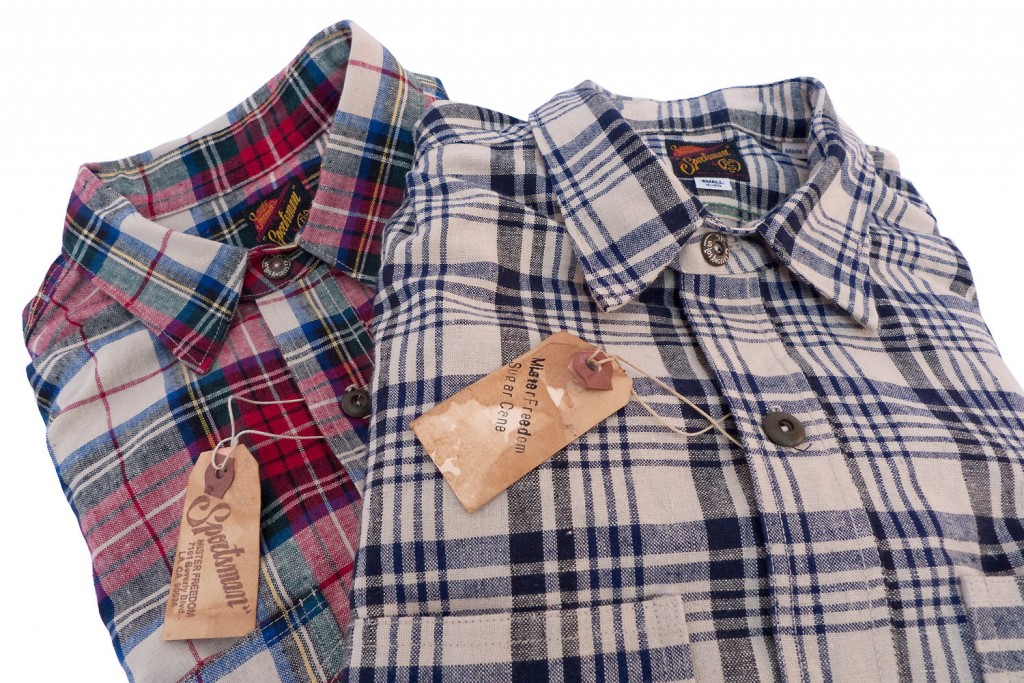
Sportsman Shirt, Tartan edition.
“The Sportsman” catalog, Fall 2014
This might come as a disappointing piece of news to you, but if you were thinking of sporting a Balmoral Tartan kilt this winter, fuhgeddaboudit. You’d need the approval of Her Majesty The Queen. I heard this takes a while. She’s busy.

A Tartan could be described as “a design which is capable of being woven consisting of two or more alternating coloured stripes which combine vertically and horizontally to form a repeated chequered pattern“, as per the very official Scottish Register Of Tartans.
It turns out some of the 90°-angled geometrical designs we, barbarians, refer to as plaids find their origin in the Highlands of XVIIIth Century Scotland. With such a rich historical background to explore, it is tempting for me to rewind back to 1538, and mention King James V’s hose. No, not the courtesans, the plaid tights he wore.
 James V of Scotland’s selfie So, before this gets out of hand, here is where Mister Freedom® cometh in.
At this point, you’re saying “Show me da goods foo! Where’s my MF® F/W 2014 ERDL kilt?!”
Holdeth thy horses Sire, I says. That’s up next season. For now, alas, we have opted to entertain your brave heart spirit with a simple Sportsman Shirt, in two funky fresh options:
a) A cloth in the style of a “Dress Stewart” tartan, woven plaid with a red dominant, 50% cotton 50% linen blend.
b) A cloth in the style of a “Dress Menzies” tartan, woven plaid with a white dominant, 50% cotton 50% linen blend.
Both fabric options are milled in 日本, Empire of the Sun.
Ali Ghetto, don’t touch my mustache.
The shirt pattern is our classic Sportsman Shirt body, featuring the usual signature details such as inverted box-pleat pocketing, shoulder expansion pleats, inside green chain-stitch, metal cast buttons, side gussets, chin strap, American manufacture…
Now, on a side note, dig this.
Our local factory decided to improvise and share with us their open-edge side gusset technique. Thanks guys, that’s very special. This is the same group of savvy experts who had, in the past, opted to overlock the edge of a perfectly fine vintage selvedge chambray fabric so that… it wouldn’t unravel.
 I respect your talent, but my wife doesn’t like it This time, while checking this proudly made in USA production, we realized the single layer gusset piece had, not only no selvedge, but was cut on a bias with unfinished edges (a traditional gusset is either a selvedge single layer or folded over double layer piece of fabric)…
Luckily, this flaw will in no way jeopardize the integrity of the seam of our shirt. But the edge of the gussets will fray with washing. Rugged daddy style, which some brands charge extra for.
Of course this stays between you and I. Let’s just say Mister Freedom® is starting a trend here. Soon at a mall near you, as we’ve seen worse things catch on.
UPDATES!!!
Liz called and said we’d better fix the gussets, and on the quickness. So we can all move on, here is what we did. The shirts will come with hemmed side gussets, as picture front and back on these macro shots. The fellow staring at your gussets next to you will see a top stitch.
We understand if this is unacceptable to some, and will gladly suggest other options. We’re not pushy.
Our Sportsman Shirt Tartan edition is designed and made in California by Mister Freedom®, in collaboration with Sugar Cane Co, with the help of a few local skilled geniuses. Fabric milled in Japan.
SPECS:
PATTERN: An original MFSC pattern, inspired by our usual vintage influences.
FABRIC:
Two options
a) A “Dress Stewart” style fabric (woven plaid with a red dominant), 50% cotton 50% linen. Milled in Japan.
b) A “Dress Menzies” style fabric (woven plaid with a white dominant), 50% cotton 50% linen. Milled in Japan.
DETAILS:
* Relaxed silhouette and fit.
* Original chest inverted box-pleat double pockets.
* Slim chin strap.
* Full button front.
* MF® original olive green painted embossed metal buttons, combination solid and MFSC branding.
* White cotton popeline button facing strip.
* Double front & back expansion pleats on shoulder yoke.
* One piece cuff gusset.
* 100% cotton thread, high stitch count.
* Flat felled seams, with inside green chain-stitch MF® signature.
* Fashion-forward side gussets, very special.
* Original “The SPORTSMAN” woven rayon label.
* Made in California, USA.
SIZING/WASHING
This plaid shirt comes raw/unwashed and both options will shrink to tagged size.
We recommend an initial cold rinse and line dry. Do not use hot water or heat dryer, as this will result in excessive shrinkage.
It is the nature of linen to always look wrinkled after being rinsed. This is not a flaw, but one of the few differences between linen and polyester jersey.
Our blend of 50% linen and 50% cotton feels quite ‘dry’ and will soften overtime, with normal wash & wear cycles.
If you are usually a Medium in mfsc shirting, you are a Medium in the Sportsman Tartan.
Please refer to our sizing chart for measurements of raw and cold-rinse/line-dry garments.
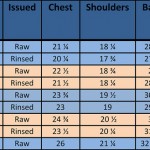 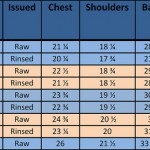
Available RAW/unwashed.
SIZES:
14½ (Small)
15½ (Medium)
16½ (Large)
17½ (X-Large)
18½ (XX-Large)
RETAIL $289.95
Available from www.misterfreedom.com
Email sales@misterfreedom.com or call 323-653-2014 with any questions unanswered above.
Thank you for your support.
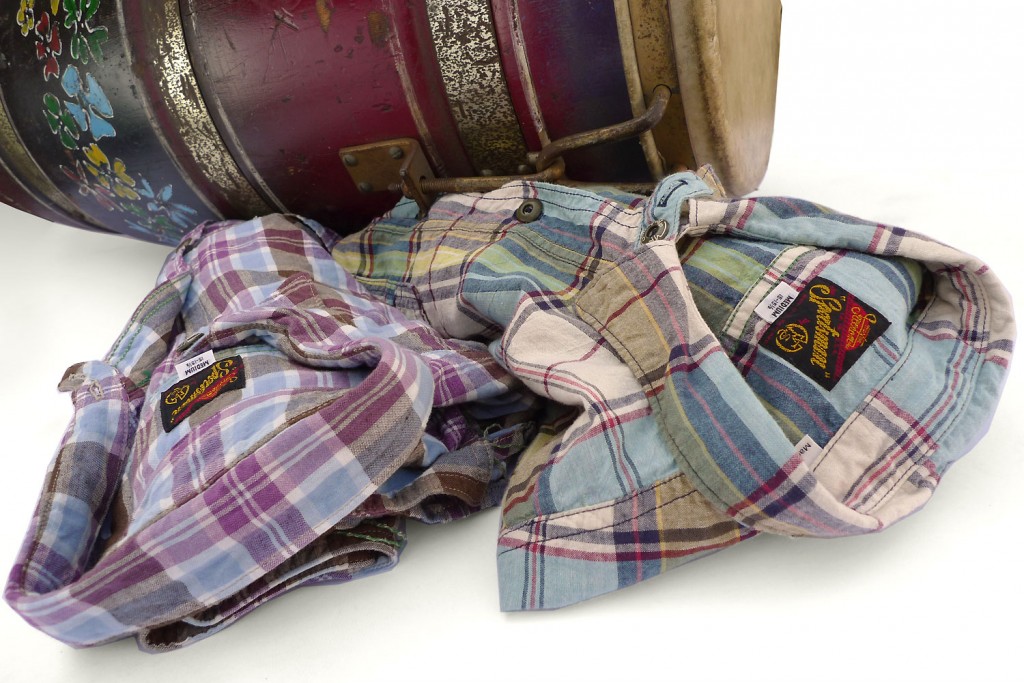
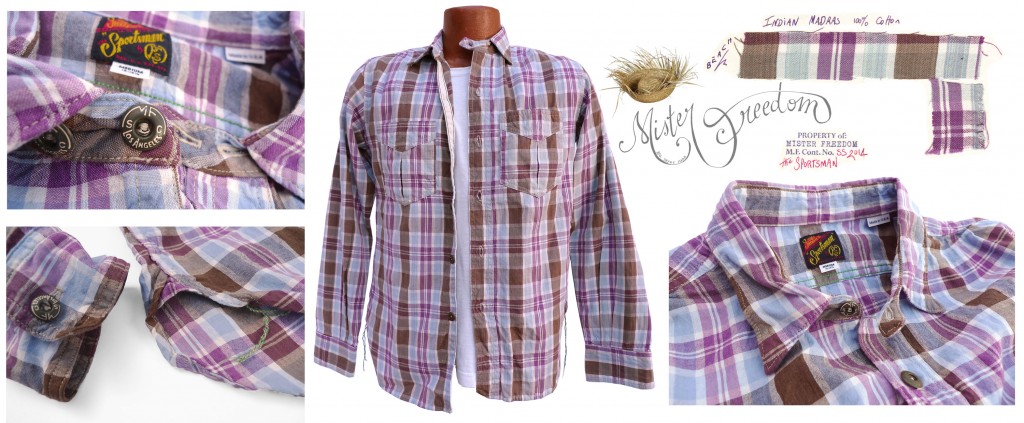
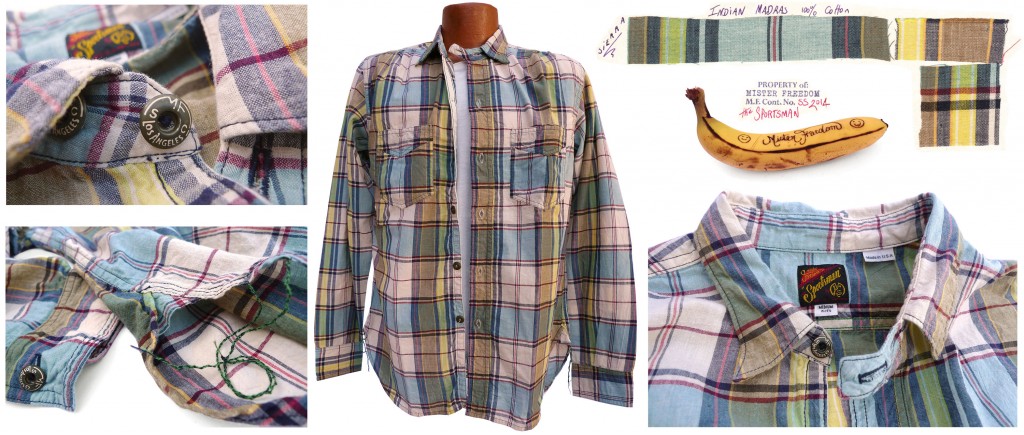
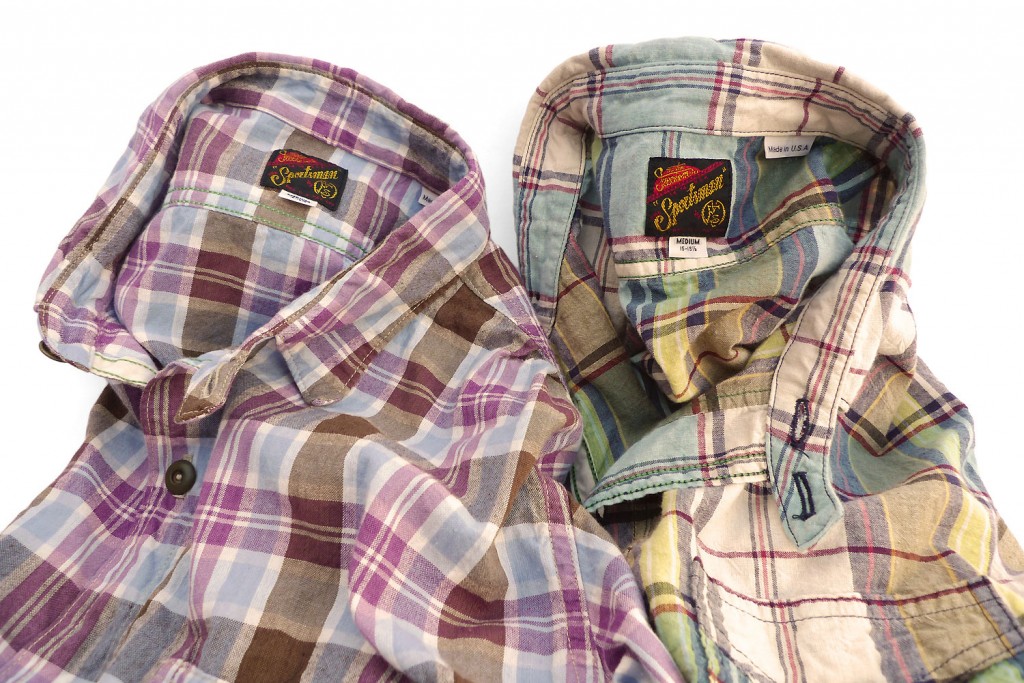
Indian Madras Sportsman Shirt
“The Sportsman” Catalog Spring 2014
Originally a plain cotton muslin of loose weave, madras textiles were lightweight and breathable fabrics, a perfect fit for the hot climate of the Madras (now Chennai) region, Southeast India.
In the 1800’s (I know, at least I left out the early Dutch settlers stories), the area many weavers were also producing ‘Madrasi checks’, a local interpretation of the Scottish tartans some occupiers were sporting. Out of some 200 weaving villages came out countless patterns of hand loomed plaids, in bold vegetable dyed colors…
The typical and desirable slubby aspect of a madras type fabric is due to the fact that the yarn is carded and not combed, resulting in variations of thickness and fluctuating texture. That slub is something close to impossible to duplicate for modern factories instructed to emulate random ‘imperfections’. In Chennai, they had it…
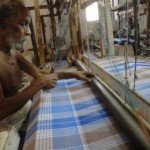 Photo Courtesy of A.K. Muralitharan For those interested in historical anecdotes, here is a quite interesting twist of event. How a croaking problem turned into a oh-so-desirable effect, thanks to a last minute marketing strategy concocted to liquidate defective stocks of non color-fast madras fabrics.
One of the version of the “Guaranteed To Bleed” story goes like this. It dates back to sometime in 1958 or 1956 (according to the source) when…
“… the leading textile importer William Jacobson embarked on a trip from the U.S. to Bombay in the hopes to return with this exotic fabric from India.
Upon his arrival, the local textile Commissioner Mr. Swaminathan directed him to Captain C.P.Krishnan Nair the proprietor of Leela Scottish Lace Ltd, a textile exporting company from Chennai ( modern day Madras) who presented Jacobson with a fabric that he fell for right away. It was a Madras plaid fabric with a strong smell of vegetable dyes and sesame oils that was dyed in vivid colors that was originally made for export to South Africa. Mr. Nair was delighted to supply Mr. Jacobson with the Madras fabric at $1 per yard, warning him that the fabric required utmost care when laundering because the color would run out if it wasn’t gently washed in cold water.
The American exporter sold ( 10,000 yards ) of the same fabric to Brooks Brothers who manufactured trousers and jackets (which sold for $50) . However Jacobson failed to fully explain the properties of the fabric and did not issue washing instructions to Brooks Brothers.
Customers were furious when they saw the colors run that ruined their expensive summer apparel. Jacobson was likewise furious and summoned Mr. Nair to the United States where his attorneys threatened to sue Mr. Nair and the Leela Scottish Lace Ltd.
Instead of fighting each other they came up with solution that was sheer marketing genius! One of the attorneys arranged an interview for Mr. Nair with the editor of Seventeen Magazine in which he created a story about this miracle Madras fabric from India that was exclusively made for Brooks Brothers in New York. In the following issue, the editor ran a seven-page article about fabric titled “Bleeding Madras — the miracle handwoven fabric from India”. And since pictures say more than 1,000 words, they added beautiful photographs with the caption “guaranteed to bleed”.
Within a days of the magazine hitting the newsstands, Brooks Brothers was flooded with thousands of requests for the Madras items and it became an overnight success. Both, Mr. Jacobson and Mr. Nair made a fortune from the sale and paved the way for future Indian fabric exports of millions of yards of Madras cloth.”
Of the power of a few photos and chosen words in a magazine, eh?
If only the Fashion media would put that magic formula to good use more often… But, paying sponsors are about moving more widgets, not about doing less damage. So we might never see the end of factory distressed garment ads…
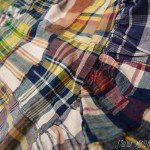 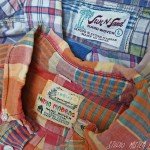 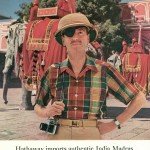
Randomly fast forwarding to the summer of ’65, direction the preppy side of Southern California. If you owned two shirts on Campus, chances are one of them was a short sleeved cotton Madras plaid shirt. For many preps, and even a few tambor beating beatniks, these were the go-to shirts. ‘Inland’ surfers wore madras plaid regatta shirts. Golfers figured madras plaid pants were a great idea. Greasers couldn’t be bothered…
For Spring 2014, we were fortunate to get our hands on two limited runs of genuine Indian Madras.
Although the lots we secure were not hand loomed by Anakaputhur villagers in the summer of 1912 and of a fairly recent manufacture, the fabrics are reminiscent of vintage Madras. Loose weave, light weight, breathy, slubby… These two specifically caught my eyes as I originally flipped through a few thousands swatches of available madras stock last year. There was, what I thought of, a cool sixties vibe to both, a non-contemporary feel.
In the 1990’s, I was lucky to be schooled on vintage madras shirting by my good buddy Kenny Thomas, then a designer for Ralph Lauren, constantly looking for inspirational plaids to adorn the little guy on a horse with. Kenny is now both the talented front man and designer behind the Grayers brand. Yes, he also takes photos and makes timeless comments on Instagram…
Back to our horses here, please note that our madras are not ‘bleeding madras’, as non color-fast dyes have proven too challenging for the average customer through the years, and have slowly disappeared from garment manufacturing.
Our Sportsman Madras Shirts will just fade like regular garments do when washed and worn repeatedly.
We arbitrarily called our two madras fabric options ‘Beach‘ and ‘Sierra‘, however tempting Padmanabh (One With Lotus In His Navel) and Gajanan (One With Elephant Face) were. We decided to go with simple on this one.
For the pattern, we used our ‘classic’ Sportsman shirt specs, featuring some MF® ‘signature’ details such as original pocketing, shoulder expansion pleats, inside green chain-stitch, metal cast buttons, side gussets, two arms…
Style wise, the unlikely pairing of a 60’s plaid madras vibe with workwear type shirting sounding like a big no-no, we immediately went for it.
The result is a simple, casual looking long sleeved cotton plaid shirt. It’s easy to match with denim, chinos, wheat jeans, pleather bikinis… Although not shirtjak (ie. cropped by contemporary streetwear standards), this shirt can be worn tucked-in or out.
For more exquisite pairing inspiration, the interweb abounds in illuminated suggestions. And so do, at times, vintage ads…
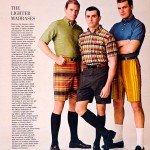 A fierce 1963 ad Our Indian Madras Sportsman Shirt is designed and made in California by Mister Freedom®, in collaboration with Sugar Cane Co. Made from genuine imported Indian Madras.
SPECS:
PATTERN: An original MFSC pattern, inspired by our usual vintage influences.
FABRIC:
Two options:
a) Madras ‘Beach‘: 100% cotton woven plaid muslin, with dominant brown/sky blue/washed-out-plum, woven in India.
b) Madras ‘Sierra’: 100% cotton woven plaid muslin, with dominant turquoise/white/brown/yellow, woven in India.
DETAILS:
* Relaxed silhouette and fit.
* Original chest inverted box-pleat double pockets.
* Slim chin strap.
* Full button front.
* MF® original olive green painted embossed metal buttons, combination solid and MFSC branding.
* White cotton popeline button facing strip.
* Double front & back expansion pleats on shoulder yoke.
* One piece cuff gusset.
* 100% cotton thread, high stitch count.
* Flat felled seams, with inside green chain-stitch MF® signature.
* Side gussets with self fabric.
* Original “The SPORTSMAN” woven rayon label.
* Limited run.
* Made in California, USA.
SIZING/WASHING:
The Sportsman Madras shirt is pretty low maintenance. Wash and wear type stuff.
Due to the loose weave of the fabric however, we recommend to wash on delicate cycle, to avoid snagging.
Cotton madras looks and feels also better after laundry than when raw. When dry, the wrinkled aspect is desirable with this type of textiles. I am not a big fan of perfectly ironed shirts anyways, personal preference. My socks however…
Both fabric options will shrink to close-call same measurements, according to who takes them and how much pulling and attention is applied.
Our sample in-house rinse tests were done with cold water/gentle cycle/machine dry.
If you are usually a medium in MFSC Sportsman shirting, wear a medium in the Madras.
Shirts will shrink to tagged size. Please refer to chart below for measurements:
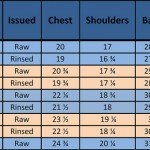
Available RAW/unwashed.
SIZES:
14½ (Small)
15½ (Medium)
16½ (Large)
17½ (X-Large)
18½ (XX-Large)
Retail $289.95
Soon available on www.misterfreedom.com
Please call 323-653-2014 or email sales@misterfreedom.com with any questions not answered above, such as the name of our fruit sponsor etc…
Thank you for reading and the continuing support 🙂
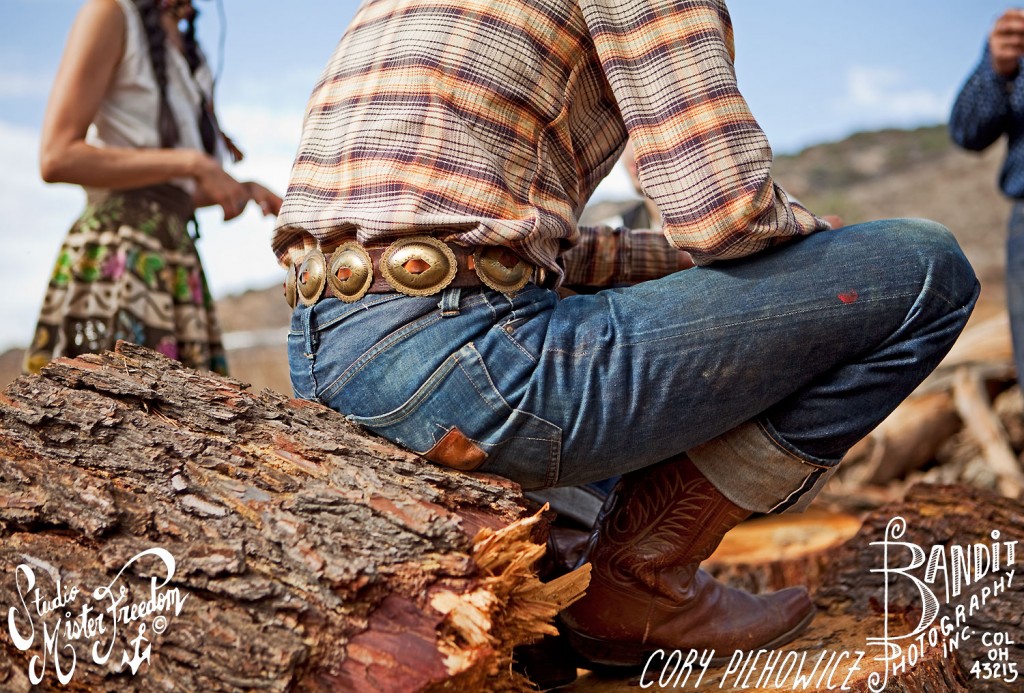
Mister Freedom® MFSC ‘RANCH HAND’ shirt
‘Men of the Frontier’ Collection, Fall 2012
We caught up with our horsemen back at the bivouac, after somewhat of a wild ride… In time to introduce the 7th installment of our Fall 2012 collection: The ‘Ranch Hand’ flannel shirt.
Alert the medias, this shirt is our first plaid flannel shirt ever! Never a dull moment in our MFSC collaboration with Sugar Cane Co, eh 😉
We based the woven plaid pattern/weight on a vintage ‘King Kole’ work shirt from our inspiration sample stash. We then picked each yarn apart and combined our own colors to create two different yarn-dyed plaid fabrics exclusive to MFSC, milled in Japan in a small batch. Should you see the exact same plaid from another company next year, you’ll know where it came from.
Our ‘Ranch Hand’ body pattern and cut are inspired by a range of 1930’s~40’s dress shirts, western shirts and work shirts, not the more common ‘Big Mac’ type flannel shirts. We also opted for painted metal snap buttons, a nod to vintage 1950’s ‘Maverick’, Blue Bell Wrangler® and Penney’s ‘Ranchraft’ plaid flannel shirts.
Designed in California by Mister Freedom® and crafted in limited edition by Sugar Cane Co in Japan for our collaboration MFSC collection.
SPECS:
PATTERN: An all original MFSC® pattern, inspired by 30’s and 40’s shirting.
FABRICS: Two options, woven in Japan.
a) ‘Turquoise’ woven plaid: 100% cotton 8 oz. Yarn dyed, color combination teal/turquoise/off white/red
b) ‘Sienna’ woven plaid: 100% cotton 8 oz. Yarn dyed, color combination brown/beige/orange/yellow
We do not use chemical washes to make our garment look/feel ‘vintage’, we address that at the pattern design stage.
DETAILS:
* All original MFSC pattern, slimmer silhouette.
* Narrow chin strap collar, with 1920’s NOS french glass buttons.
* Indigo dyed cotton popeline button placket facing and collar facing.
* Original double chest pockets, box pleat type, with indigo popeline reinforcement patch on inside.
* “Dot” white painted metal snap front and cuff closure (the paint will slowly chip off with wear/wash)
* ‘Tear drop’ front tail shape, with overlap, to keep that belly to yourself.
* Selvedge indigo popeline side gussets.
* Curved back shoulder yoke.
* One piece folded cuff placket.
* Original woven MFSC label on tucked-in front tail, stamped with sizing.
* Double needle flat felled seam side construction.
* High count stitching, 100% cotton ivory color thread.
PACKAGING: Sturdy cardboard box with MF® original ‘finer than frog hair’ artwork. Please re-use and recycle.
SHRINKAGE/SIZING: Both fabric options come raw/unwashed.
After shrinkage, both plaids will shrink to the same specs. I am a 38/medium/15½ in MFSC shirting, and I wear a 15½ in the ‘Ranch Hand’ shirt.
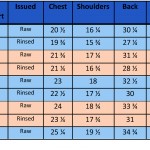
We recommend an original cold gentle cycle, and line dry. Subsequent washing should be done with turning the shirt inside out, gentle cycle with eco-friendly mild detergent. Line dry is preferred.
Let the colors fade naturally with normal wash/wear.
Available RAW/unwashed
Sizes
14½ (small)
15½ (medium)
16½ (large)
17½ (xlarge)
18½ (xxlarge)
Retail $379.95
Call 323-653-2014 or mail sales@misterfreedom.com to get yours while they last. We ship internationally to select Countries. Thank you again for the continuing support, friends.
|




